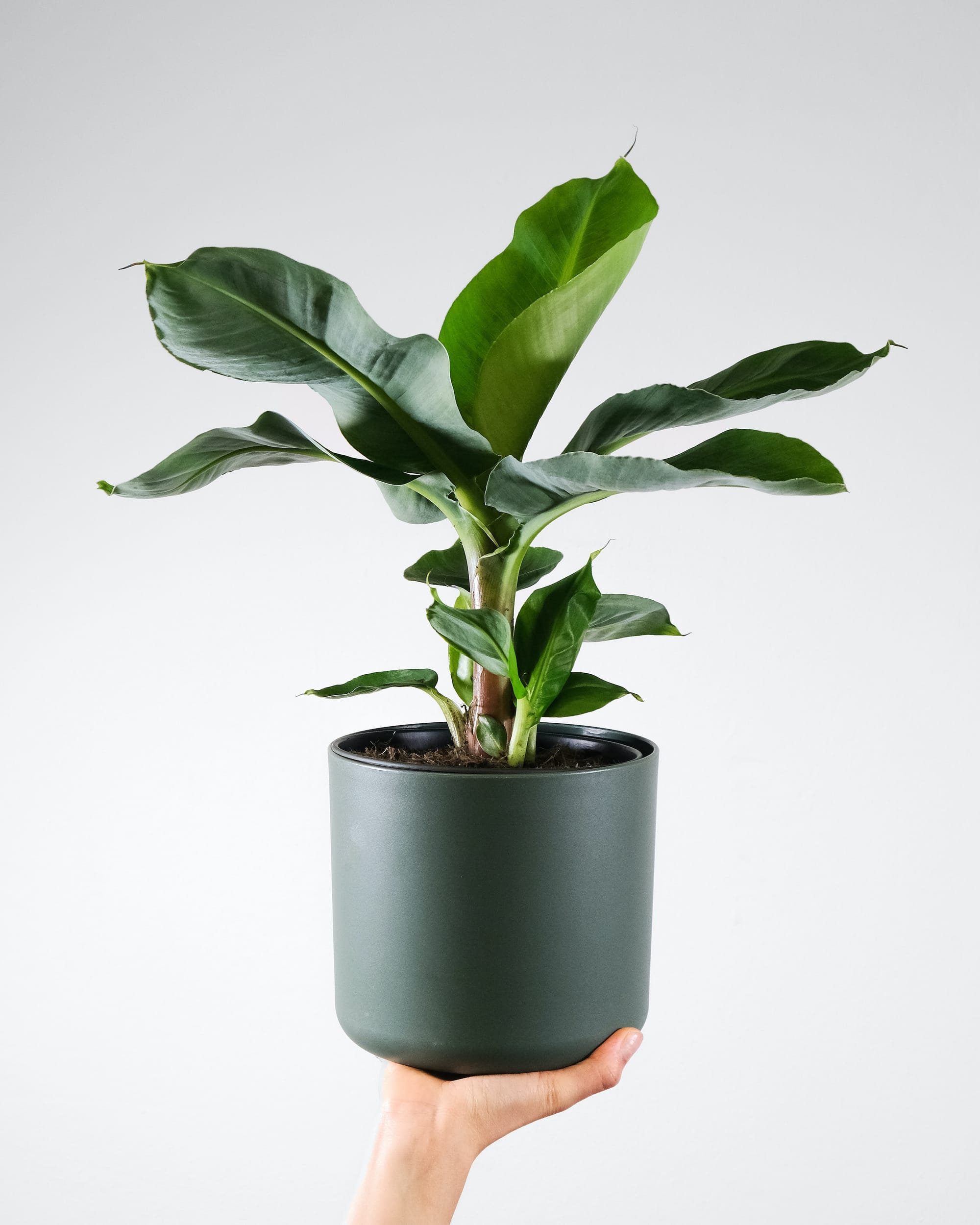
Musa acuminata 'Dwarf Cavendish'
Contents
- Top Tips
- Location, Water, Humidity & Fertilisation
- What Happens if my Banana Loses All of its Leaves?
- Common Issues
- Origins, Temperature, Propagation, Repotting & Toxicity.
Need the answer to a specific plant query? Book a 1-to-1 video call with THE HOUSEPLANT DOCTOR™, the website's friendly author, to overcome and address your niggling problem! Available on iMessage, WhatsApp, Facebook Messenger & more.
Top Tips & Info
- Care Difficulty - Moderate
- Banana Plants are best equipped for locations that provide bright, indirect light. Areas that are too dark will significantly increase the risk of root rot, along with slowed growth and yellowing older leaves.
- Allow the top half to dry out in between waters, reducing this further in the autumn and winter. Over-watering during its dormancy period is a common issue among owners, so always bear this in mind when the colder months arrive.
- Fertilise using a 'Houseplant' labelled feed every four waters in the spring and summer, reducing this to every six in the colder months.
- Keep an eye out for Spider Mites that'll form webs on the under-sides of its foliage. Aphids can also attack the juvenile growth once the temperatures start to increase in the spring.
- Especially if located in a dark location, wash or dust the foliage monthly, to increase the light-capturing efficiency.
- Repot every two or three years using 'Cactus & Succulent' soil and the next sized pot with drainage holes. We recommend using terracotta as a substitute for plastic pots.
Location & Light - 🔸🔸🔸
Bright, indirect light is best for Banana Plants, as their tendency of root rot is heightened in darker environments. Be sure to include around two hours of sunlight per day throughout the dormancy period, lasting from early autumn until mid-spring. The sun's warmth will gradually dry out the soil quicker, along with providing vital nutrients to get the specimen through the backbone of its dormancy. Over-head lighting will ensure equal 360º growth and prevent the risk of lopsided growth when situated too far from the source of light (windows, etc.).
Water - 🔸
Banana Plants and over-watering can be synonymous if given too much water or not enough light. As its main body is largely water-retentive, evolution has served it with the ability to endure short-lived droughts. With this in mind, only rehydrate the soil once the top half has become dry, reducing this further in the autumn and winter. Under-watering symptoms include a greyish appearance, wilting or curling leaves, brown distorted new growth and basal offset death. Over-watering symptoms include yellowing lower leaves, powder on the plant's main body, mouldy or heavy soil, basal offset death and a softened stem. Take the specimen out of its pot and inspect its root health; if you feel that root rot has taken over, be sure to visit this link!
Humidity - 🔸🔸
Create a humidity tray to provide a moist and stable environment for your plant. If the surrounding saturation is too low or the heat too high, its leaf-tips may start to brown over and curl, especially in direct sunlight. Hose the foliage down from time to time to hydrate the leaves and keep the dust levels down.
Fertilisation - 🔸🔸
Feed every four waters during the growing period and every six in the autumn and winter, using a 'Houseplant' labelled fertiliser. Never apply a 'Ready to Use’ product into the soil without a pre-water first, as it may burn the roots and lead to yellowed leaves.
What Happens if my Banana Loses All of its Leaves?
Especially common with outdoor varieties of Banana Plants, some specimens may gradually lose their foliage within a couple of weeks or months. If the plant's basal stem/roots look plump and healthy, there's no need to panic. Chances are, your beloved Banana Plant is going through a state of dormancy and therefore is turning its leaves yellow and brown for a well-earned rest! Instead of tossing the specimen in the bin, simply keep it in the soil/pot and relocate the plant to a partially sunlit windowsill. The natural warmth from the sunlight should allow the specimen to rest for a few weeks before spurting up the courage to develop new foliage. During this time, allow the majority of the compost to dry out before drenching the soil over the sink. Add some fertiliser into every fifth or sixth water, and watch out for the new coiled growth that'll emerge from the base!
If, however, you feel that the specimen does indeed have issues of root or basal rot, you can always book a 1-to-1 Call with our author, Joe Bagley, to get his expert advice on what to do next. Remember - Banana Plants are true fighters, so always remain optimistic when helping a poorly specimen!
Common Issues with Banana Plants
Rapidly yellowing lower leaves (closest to soil) with no new growth are a clear sign of over-watering, usually caused by too little light. Although Banana Plants can do well in darker locations, the frequency of irrigations must be reduced to counteract the chance of root rot. People don't realise that a plant's root system needs access to oxygen too; when soil is watered, the air will travel upwards and out of the potting mix. A lack of accessible oxygen for the roots will cause them to subsequently breakdown over the oncoming days. Click on this link to learn more about root rot and how to address it.
Large yellowing sections along its leaves or leaf-edges could be the product of many issues, ranging from Spider Mites to chemical burns. Think about its recent cultivation of how frequently you rehydrate its soil, along with a quick scan over the foliage's undersides. The use of 'Leaf Shine' or other chemical-based products may also have a detrimental effect on its health, as Banana Plants are particularly sensitive to inorganic substances. Prune the entire leaf off via the petiole and investigate the rest of the plant for a potential spread of the problem.
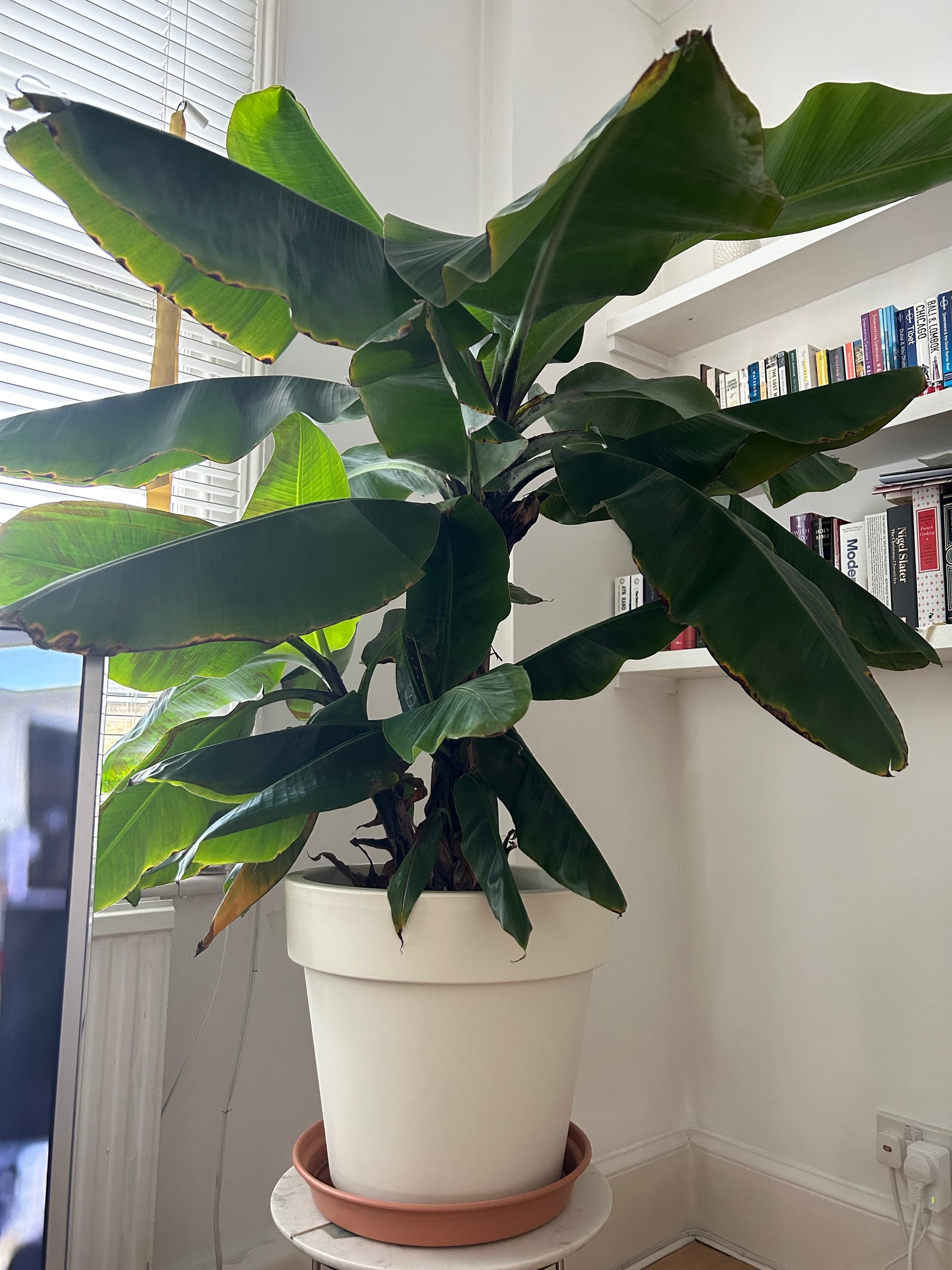 Small or insignificant yellowed leaf-edges are entirely natural with every Banana Plant, so don't worry if the plant is still growing and looks healthy; it's just maturing with age!
Small or insignificant yellowed leaf-edges are entirely natural with every Banana Plant, so don't worry if the plant is still growing and looks healthy; it's just maturing with age!
Mould developing on the soil means two things - too little light and over-watering. Despite the harmlessness, it'll prove unsightly to most gardeners and is therefore removed once known. To remove, replace the top two inches of the soil for a fresh batch of 'Cactus & Succulent' labelled compost. Either increase the amount of light received (no direct sunlight for the first few weeks to prevent environmental shock) or decrease the frequency of waters slightly. If the mould is accompanied by yellowing lower leaves, you may also have a case of root rot.
White dusty markings on your Banana Plant are just mineral deposits from hard water. If you live in an area with this, try using an aquatic water softener like 'Seachem Prime' that'll remove hard metals, minerals and chlorine. You can also use this to wipe the leaves to remove the dusty markings.

If your Banana Plant has become brown and crispy like the above, THE HOUSEPLANT DOCTOR™ recommends pruning off the leaves and roots until you're left with just the stem. This is where the 'corm' will be, which acts like a bulb. If the centre of the stem (corm) is green and plump, remove any remaining dead flakes from it to expose the fresh tissue around the outside. Then, place it in a 10cm pot of 'Cactus & Succulent' labelled compost around 5cm (2in) deep. Water once a week and provide a sunny window - the plant might burst back into life!
Due to its sensitivity to chemicals, Leaf Shine shouldn't be used to improve the appearance of the foliage, and instead should be cleaned via a rinse of lukewarm water. Failure to do so may cause yellowed, mottled spots that cannot be undone.
Curled leaves and brown leaf-edges are the result of too little water and over-exposure to the sun. Banana Plants are best located in bright, indirect settings, and those that haven't acclimatised to the harsh rays will show signs of sun-scorch and environmental shock. A splash of winter sunlight is acceptable as long as the soil moisture is regularly observed, with complete avoidance once summer comes along.
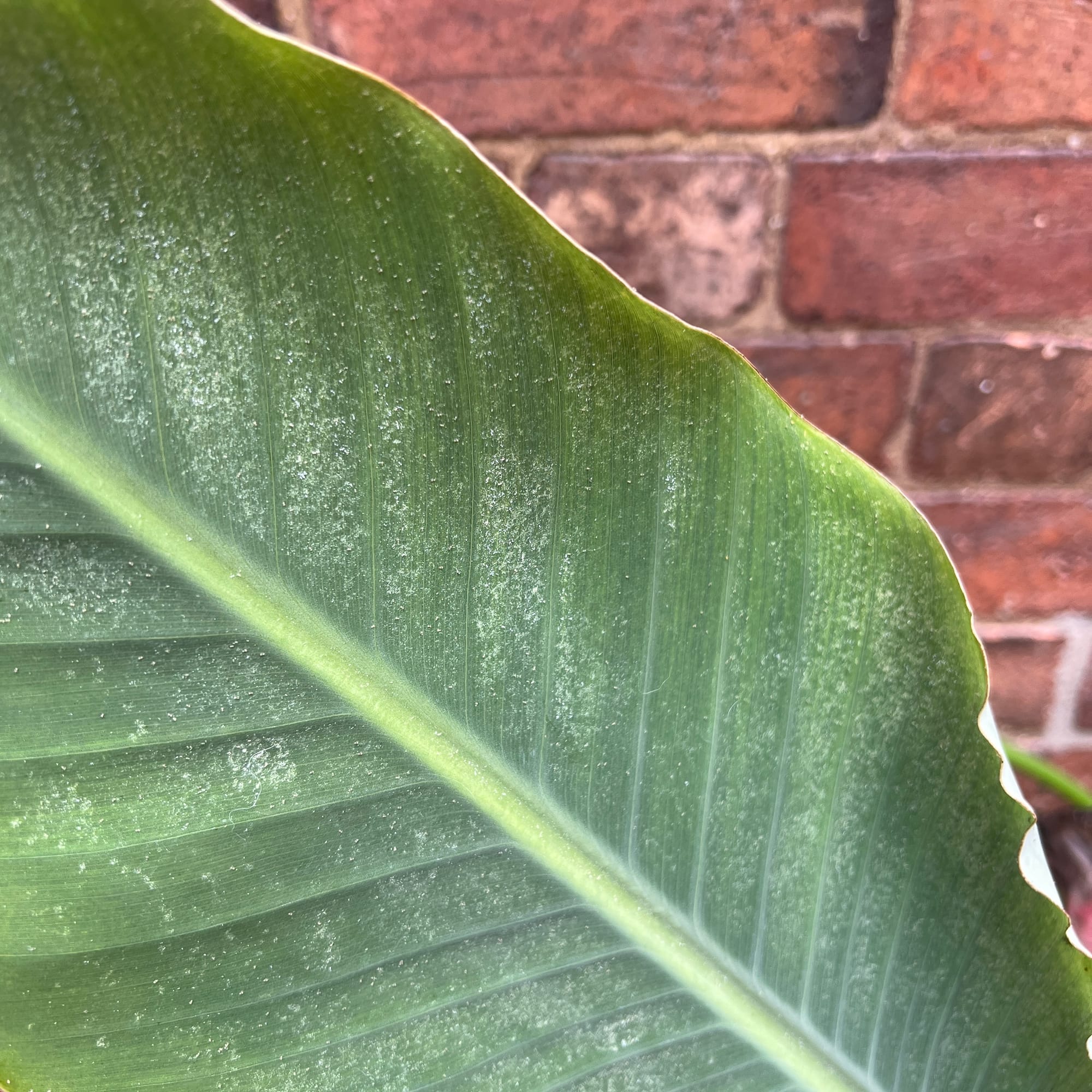
Spider Mites are small, near-transparent critters, that'll slowly extract the chlorophyll from of its leaves. Have a check under the leaves, most notably along the midrib, for small webs and gritty yellow bumps. Click here to read our article about the eradicating Spider Mites, along with some extra tips that you may not find elsewhere!
A loss of variegations is caused by too little light. Move the plant into a brighter area with minimal direct sunlight to allow the variegations to appear on the new growth. If you aren't entirely displeased about the loss, simply skip this step. Alternatively, extreme variegations that hinder the plant from developing chlorophyll (green pigmentation) is typically caused by too much sunlight.
Too low humidity can cause browning tips with yellow halos on young leaves. Although this won't kill your specimen, you may want to increase the local moisture to prevent the new growth from adopting these symptoms. Mist or rinse the foliage from time to time and create a humidity tray while the heaters are active to create a stable environment. The browning of leaf-tips on older leaves is wholly natural and is the product of extensive photosynthesis during its life.
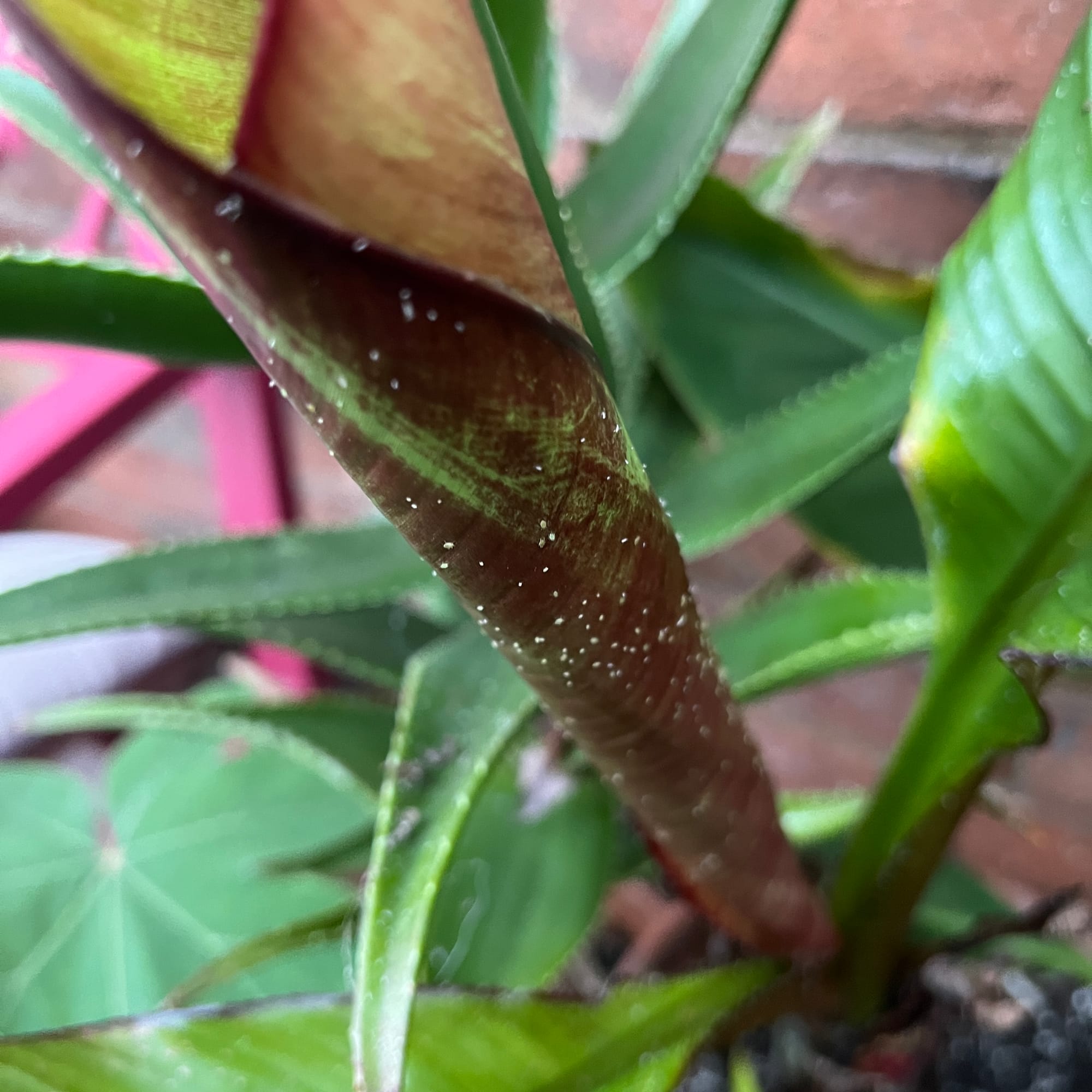
Small white or green insects appearing on the leaves are most likely Aphids. These pests are unlikely to cause significant damage to your Banana Plant as their mouthparts are too weak to 'bite' into the leaf. THE HOUSEPLANT DOCTOR™ recommends wiping the foliage down with water to remove them. Check this link for more information on eradicating Aphids.
Origins
The genus, Musa, was first described in 1753 by Carl Linnaeus, Latinising the Arabic word for Bananas (موز), which was mentioned in the eleventh-century Arabic encyclopaedia. The direct taxonomy of the Banana family is diverse and contradictory, mainly because of new seedless cultivars and naturally-occurring hybridisations that took place over the previous one hundred years.
Cavendish bananas have a unique link to Alton Towers and Chatsworth House that date way back to the 1830s. For those who aren't from the UK, Alton Towers used to be a former country estate, which is now a significant theme park, achieving over two million visitors each year. The Chaplain of Alton Towers brought over several crates of bananas from the Mauritius islands for William Cavendish, the Duke of Devonshire during that time. His friend and head-gardener, Sir Joseph Paxton, cultivated them the seeds in the estate of Chatsworth House and thus classifying them as Musa cavendishii in honour of his good friend.
Banana Plants are one of the earliest examples of domestic cultivation, that can be dated back to over one thousand years.
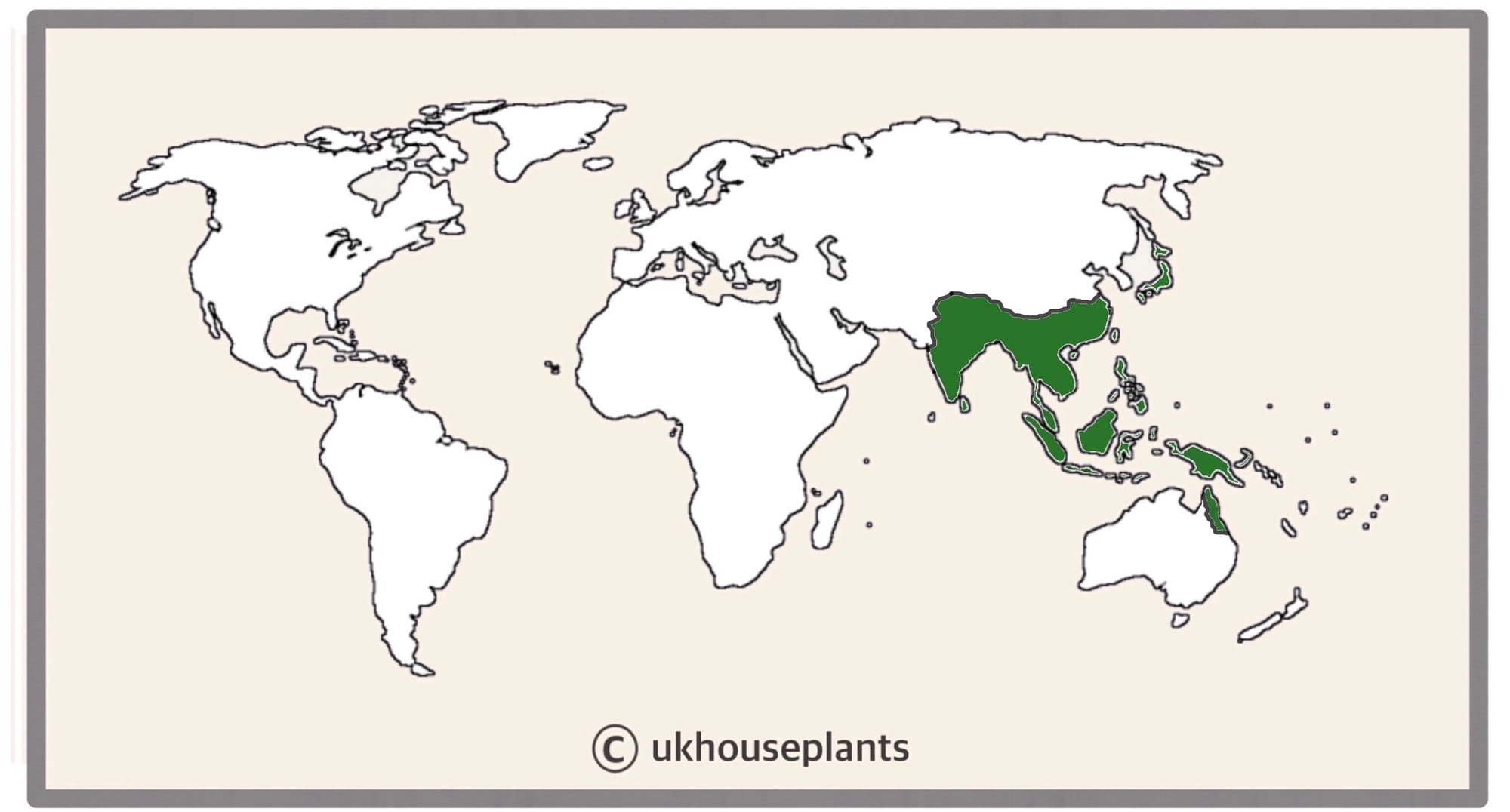 The Distribution of Musa Bananas.
The Distribution of Musa Bananas.
Temperature
10° - 38°C (50 - 100°F)
H1b (Hardiness Zone 12) - can be grown outdoors during the summer in a sheltered location with temperatures above 12℃ (54℉), but is fine to remain indoors, too. If you decide to bring this plant outdoors, prevent it enduring excessive direct sunlight or high winds due to the heightened risk of leaf-scorch and dehydration. Regularly keep an eye out for pests (Mealybugs & Aphids) when re-introducing it back indoors.
Spread
Dwalf Varieties can surpass 1.2m in height and 1.0m in width, with larger specimens (like M. ensete, M. basjoo & M. × paradisiaca) reaching over 2 - 3m after several years. The ultimate height will take around 6 years to achieve, with many specimens surpassing 15 years in the correct cultivation.
Pruning & Maintenance
Remove yellow or dying leaves, and plant debris to encourage better-growing conditions. While pruning, always use clean utensils or shears to reduce the chance of bacterial and fungal diseases. Never cut through yellowed tissue as this may cause further damage in the likes of diseases or bacterial infections. Remember to make clean incisions as too-damaged wounds may shock the plant, causing weakened growth and a decline in health.
Propagation
Via Seed or Basal Offset Division (Pups).
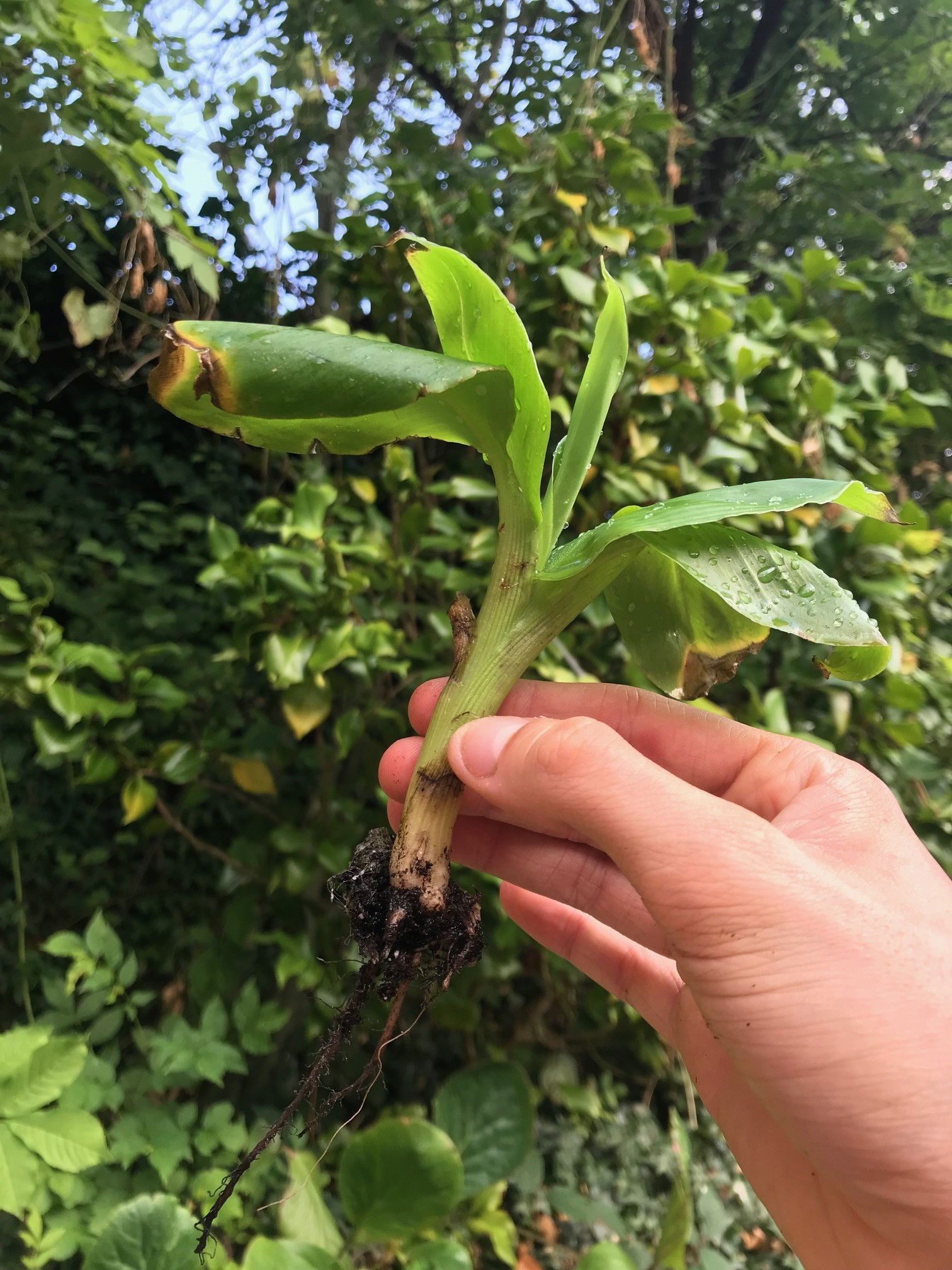 The perfect example of a 'Pup' consists of healthy, damage-free leaves, a hardened base and a sufficient root system.
The perfect example of a 'Pup' consists of healthy, damage-free leaves, a hardened base and a sufficient root system.
Basal Offset Division (Easy) - Your plant will produce several basal offsets that can be separated once they have a sufficient root system, and surpass 10cm in height. If possible, water the soil 24hrs before the main event to reduce the risk of transplant shock, when its dry root systems are over-fingered. Take the plant out of its pot and place your fingers close to the nodal junction - compost may have to be removed for better access. Push the chosen offset downwards until you hear a snap. Separate the foliage and its root system away from the mother plant, mentally noting the high risk of damage. Transplant in the appropriate sized pot with a fresh batch of 'Cactus & Succulent' labelled compost. Maintain evenly moist soil and situate it in a bright, indirect location away from any direct sunlight. After three weeks, treat it like a healthy specimen, following the care tips above!
Flowers
A stalk will form deep beneath the stem's base before emerging from its top after several weeks of development. Its flowers are arranged in a zigzag format, similar to the Bird of Paradise inflorescence that will hold up to pollination sites. Each Banana stem plant will only bloom once and will redevelop stalks on matured offsets via its rhizomes. It's highly unlikely that a domestically grown banana plant will produce flowers or fruits due to the insufficient growing conditions of dry air and consistent annual temperatures.
Repotting
Repot every two to three years in spring using a 'Cactus & Succulent' labelled potting mix and the next sized pot with adequate drainage. Bananas are a 'family plant' and therefore the mother plant can happily grow with its pups for many years, even if this means over-filling the pot. They prefer to be potbound as this will downplay the risk of over-watering (& root rot), so only repot if necessary or if you're propagating the offsets (pups).
If you were to repot your Banana Plant, hydrate the soil 24hrs before tinkering with the roots to prevent the risk of transplant shock. Use a 'Cactus & Succulent' labelled potting mix and the next sized pot, unless the rootball is significantly reduced due to the propagation of pups. We recommend using a terracotta pot as this will help with drainage and moisture absorption.
Book a 1-to-1 video call with The Houseplant Doctor™ (Author of ukhouseplants.com) if you'd like a personal guide to repotting your houseplant. This will include recommending the right branded-compost and pot size, followed by a live video call whilst you transplant the specimen for step-by-step guidance and answer any further questions!
Pests & Diseases
Keep an eye out for mealybugs, aphids, spider mites, scale, thrips, blackfly, vine weevils & root mealybugs that'll locate themselves in the cubbyholes and undersides of the leaves, with the exception of the latter two in the soil. Common diseases associated with Banana Plants are root rot, leaf-spot disease, botrytis, rust, Fusarium wilt, powdery mildew & southern blight - click here to learn more about these issues.
Toxicity
Not known to be poisonous by consumption of pets and humans. If high quantities are eaten, it may result in vomiting, nausea and a loss of appetite.
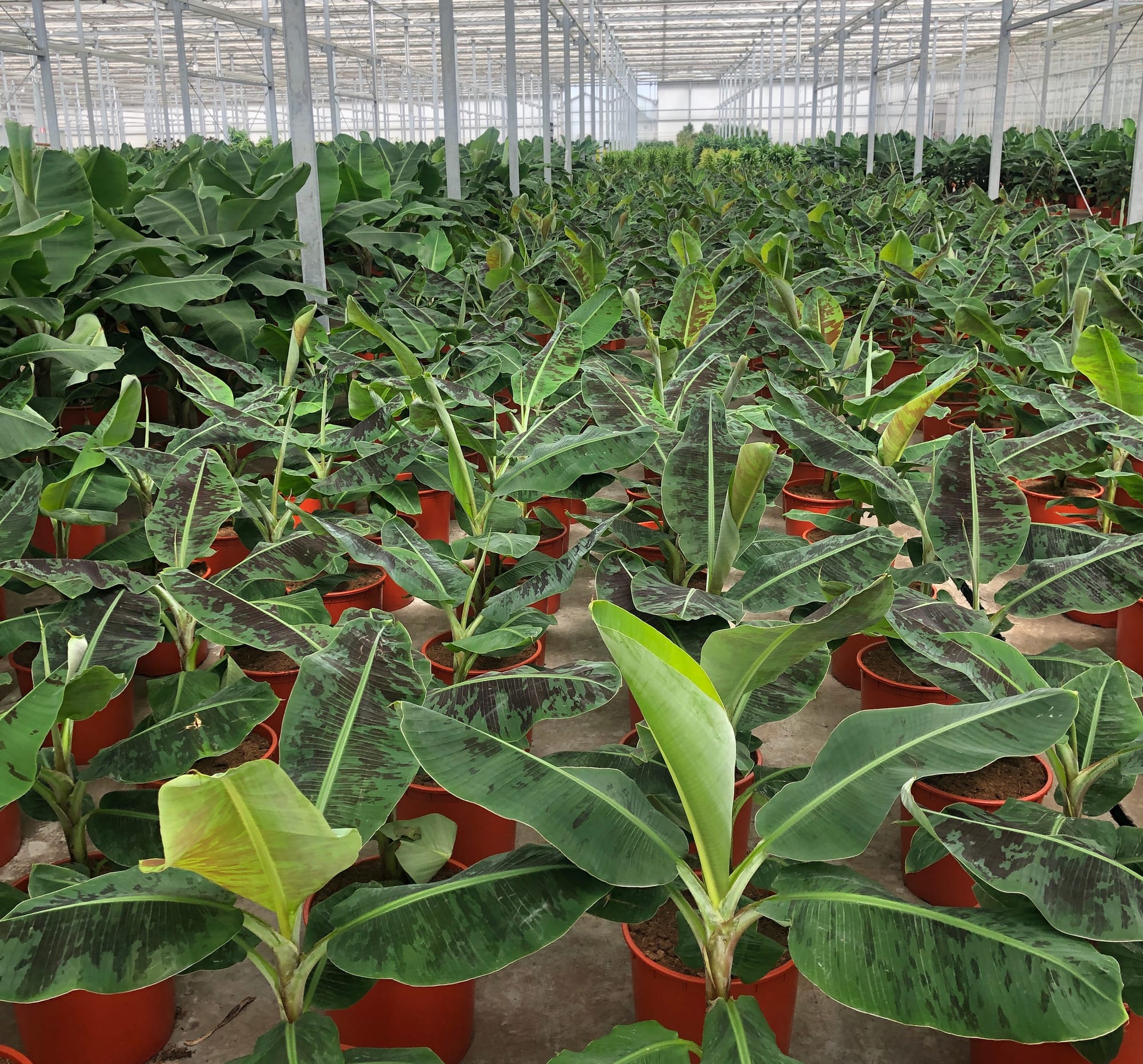
Retail Locations
Many Garden Centres or Online Stores.
Book a 1-to-1 Call with THE HOUSEPLANT DOCTOR™
If you need further advice with your houseplants, book an advice call with ukhouseplants' friendly and expert writer today! This can be done via a video or audio call on most apps, including Facebook, FaceTime & Skype. A ten-minute call costs £5.99 (US$7), or £15.99 for thirty minutes. You can ask multiple questions, including queries on plants, pests, terrariums, repotting advice and anything in between. Please consider supporting this service to keep ukhouseplants thriving!